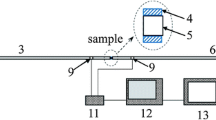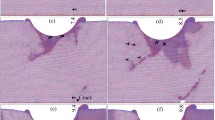Abstract
In classical twinning theory, the K2 plane of \(\left\{{11\bar 22} \right\}\left\langle {11\bar 2\bar 3} \right\rangle\) twinning mode was predicted to be \(\left\{{11\bar 2\bar 4} \right\}\), with a twinning shear of ∼0.22 which was experimentally “confirmed”. However, these twinning elements cannot be reproduced or verified in atomistic simulations. The K2 plane in the simulations is always (0001), but this K2 plane would lead to a nominal twining shear of 1.26 which is unrealistically large. In this work, atomistic simulations were performed to investigate the migration of \(\left\{{11\bar 22} \right\}\) twin boundary in titanium (Ti). Shear and atomic shuffles for three different, reported K2 planes were analyzed in great detail, for the first time. The analyses show that \({K_2} = \left\{{11\bar 2\bar 4} \right\}\) leads to very complex shuffles despite the small twinning shear and is unfavorable. If \({K_2} = \left\{{11\bar 2\bar 2} \right\}\), only half of the parent atoms are involved in the shuffling, but the twinning shear is very large (0.96) and is also unfavorable. When K2 = (0001), the parent atoms are carried to twin positions partly by shear and partly by a simple shuffle. Because shuffling makes no contribution to the twinning shear, the actual twinning shear is 0.66, instead of 1.26. Thus, K2 = (0001) is the most favorable and the conflict between the simulation results and the classical twinning theory can be reconciled.







Similar content being viewed by others
Change history
01 August 2016
An Erratum to this paper has been published: https://doi.org/10.1557/jmr.2016.252
References
B.E. Reed-Hill and E.R. Buchanan: Zig-zag twins in zirconium. Acta Metall. 11, 73–75 (1963). doi: 10.1016/0001-6160(63)90133-0.
R.E. Reed-Hill and W.D. Robertson: Additional modes of deformation twinning in magnesium. Acta Metall. 5, 717–727 (1957). doi: 10.1016/0001-6160(57)90074-3.
D.G. Westlake: Twinning in zirconium. Acta Metall. 9, 327–331 (1961). doi: 10.1016/0001-6160(61)90226-7.
B.C. Wonsiewicz and W.A. Backofen: Plasticity of magnesium crystals. Trans. Metall. Soc. AIME 239, 1422–1431 (1967).
E.W. Kelley and W.F. Hosford, Jr.: The deformation characteristics of textured magnesium. Trans. Metall. Soc. AIME 242, 654–661 (1968).
J.W. Christian and S. Mahajan: Deformation twinning. Prog. Mater. Sci. 39, 1–157 (1995). doi: 10.1016/0079-6425(94)00007-7.
N. Thompson and D.J. Millard: XXXVIII. Twin formation, in cadmium. Philos. Mag. Ser 7(43), 422–440 (1952). doi: 10.1080/14786440408520175.
F.R.N. Nabarro ed.: Dislocations in Solids: Dislocations in Crystals, Vol. 2 (North-Holland Publishing Co, Amsterdam, 1979).
S. Mendelson: Zonal dislocations and twin lamellae in h.c.p. metals. Mater. Sci. Eng. 4, 231–242 (1969). doi: 10.1016/0025-5416(69)90067-6.
B. Li and E. Ma: Zonal dislocations mediating twinning in magnesium. Acta Mater. 57, 1734–1743 (2009). doi: 10.1016/j.actamat.2008.12.016.
B. Li, B.Y. Cao, K.T. Ramesh, and E. Ma: A nucleation mechanism of deformation twins in pure aluminum. Acta Mater. 57, 4500–4507 (2009). doi: 10.1016/j.actamat.2009.06.014.
S. Mahajan and G.Y. Chin: Formation of deformation twins in f.c.c. crystals. Acta Metall. 21, 1353–1363 (1973). doi: 10.1016/0001-6160(73)90085-0.
B.A. Bilby and A.G. Crocker: The theory of the crystallography of deformation twinning. Proc. R. Soc. London, Ser. A 288, 240–255 (1965). doi: 10.1098/rspa.1965.0216.
E.J. Rapperport: Room temperature deformation processes in zirconium. Acta Metall. 7, 254–260 (1959). doi: 10.1016/0001-6160(59)90018-5.
N.E. Paton and W.A. Backofen: Plastic deformation of titanium at elevated temperatures. Metall. Trans. 1, 2839–2847 (1970).
F. Xu, X. Zhang, H. Ni, and Q. Liu: Deformation twinning in pure Ti during dynamic plastic deformation. Mater. Sci. Eng., A 541, 190–195 (2012). doi: 10.1016/j.msea.2012.02.021.
T.A. Mason, J.F. Bingert, G.C. Kaschner, S.I. Wright, and R.J. Larsen: Advances in deformation twin characterization using electron backscattered diffraction data. Metall. Mater. Trans. A 33, 949–954 (2002). doi: 10.1007/s11661-002-1027-z.
A. Serra and D.J. Bacon: Modelling the motion of {1122} twinning dislocations in the hcp metals. Mater. Sci. Eng., A 400–401, 496–498 (2005). doi: 10.1016/j.msea.2005.01.067.
B. Li, H. El Kadiri, and M.F. Horstemeyer: Extended zonal dislocations mediating twinning in titanium. Philos. Mag. 92, 1006–1022 (2012). doi: 10.1080/14786435.2011.637985.
M.S. Daw and M.I. Baskes: Semiempirical, quantum mechanical calculation of hydrogen embrittlement in metals. Phys. Rev. Lett. 50, 1285–1288 (1983). doi: 10.1103/PhysRevLett.50.1285.
M.S. Daw and M.I. Baskes: Embedded-atom method: Derivation and application to impurities, surfaces, and other defects in metals. Phys. Rev. B 29, 6443–6453 (1984). doi: 10.1103/PhysRevB.29.6443.
R.R. Zope and Y. Mishin: Interatomic potentials for atomistic simulations of the Ti-Al system. Phys. Rev. B 68, 024102 (2003). doi: 10.1103/PhysRevB.68.024102.
M. Niewczas: Lattice correspondence during twinning in hexagonal close-packed crystals. Acta Mater. 58, 5848–5857 (2010). doi: 10.1016/j.actamat.2010.06.059.
E.O. Hall: Twinning and Diffusionless Transformations in Metals (Butterworth, London, 1954).
S. Mendelson: Dislocation dissociations in hcp metals. J. Appl. Phys. 41, 1893–1910 (1970). doi: 10.1063/1.1659139.
M.L. Kronberg: Plastic deformation of single crystals of sapphire: Basal slip and twinning. Acta Metall. 5, 507–524 (1957). doi: 10.1016/0001-6160(57)90090-1.
Q. Yu, Z-W. Shan, J. Li, X. Huang, L. Xiao, J. Sun, and E. Ma: Strong crystal size effect on deformation twinning. Nature 463, 335–338 (2010). doi: 10.1038/nature08692.
R. Abbaschian, L. Abbaschian, and R.E. Reed-Hill: Physical Metallurgy Principles, 4th ed. (Cengage Learning: India, 2008).
Author information
Authors and Affiliations
Corresponding author
Rights and permissions
About this article
Cite this article
Li, B. Shear and shuffle in \(\left\{{11\bar 22} \right\}\left\langle {11\bar 2\bar 3} \right\rangle\) twinning in titanium. Journal of Materials Research 30, 3795–3802 (2015). https://doi.org/10.1557/jmr.2015.371
Received:
Accepted:
Published:
Issue Date:
DOI: https://doi.org/10.1557/jmr.2015.371




